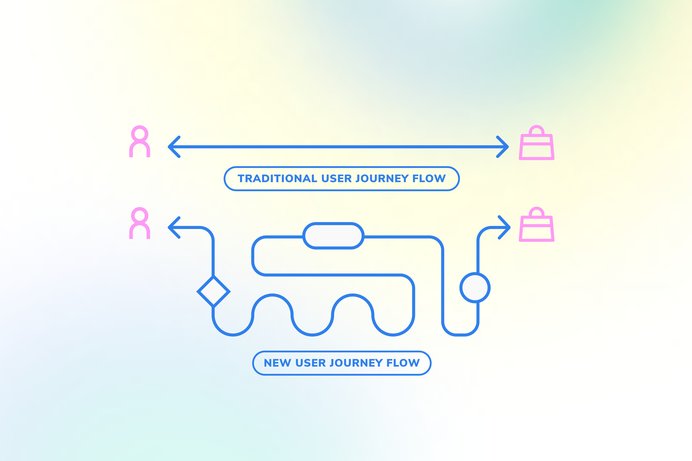No More Straight Paths: Rethinking the E-commerce User Journey for the Next Generation Shift
Discover how Gen Z’s unique e-commerce preferences are reshaping the shopping experience, why businesses must evolve beyond the traditional ‘funnel’ approach to craft non-linear, hyper-personalized, and authentic experiences, and how to get there.

The traditional focus for the e-commerce experience, characterized by prioritizing the classic, linear purchase funnel above all else, is undergoing a radical change. While this is in part due to technological advancements such as evolving omnichannel experiences, and the ever deepening shopping integrations on social apps, it's also essential to recognize the critical role of Gen Z’s preferences and expectations in shaping this evolution.
Specifically, Gen Z consumers want experiences that align with how they actually discover products and engage with brands, are hyper-personalized, and provide them with the authenticity and transparency they now expect from brand relationships. In other words, authentic experiences that transcend the transactional ‘one size fits all.’ And those expectations are rapidly being adopted by a wider customer base beyond Gen Z as well.
We've seen direct evidence of these shifting expectations repeatedly over the past year when working with our enterprise e-commerce clients on user experience and user journey audits. And the trend persists across both different verticals and target demographics.
For e-commerce businesses to thrive amidst these changing expectations- especially considering that 73% of Gen Z-ers prefer to shop online /or/ and tap into the $360 billion in purchasing power for this demographic - organizations need to update their thinking on the ‘standard’ e-commerce user journey, take a deeper look at the KPIs and metrics they track, and adopt a more holistic approach to creating user experiences, including more cross-departmental collaboration. Below are 5 key actions companies take to start on this path.
1. Embrace a Non-linear & Personalized User Journey
The traditional path from landing on a site to product browsing to purchasing is fading fast. Companies instead need digital experiences that enable users to seamlessly move between different channels and phases of their buying journey, rather than forcing users down a funnel they don’t want, too early on. Consider that any given user may opt to move from discovery to research, to product views, to reviews, to chat interactions, to buying, to sharing, to checking reviews again after the product arrives - and all the hopping in between- across social media to your site, to your app and back again. As such, your experience needs to be designed like a map, where users can choose their optimal path to conversion and then act quickly once they’re there.
It’s important that these journeys are also personalized based on past behavior, preferences, and the context of the present moment. Luckily, with new advancements in AI and data processing, it’s becoming ever more viable for companies to offer such experiences. For example, if a user frequently watches product videos but seldom reads lengthy descriptions, your site should prioritize video content for them. If you want to offer a chat interaction when a user seems indecisive, you would ideally tailor that interaction based on both the data from the current moment and the information you have on their previous behavior, instead of a standard, ‘Can I help you?’
Action item: Retrain teams to broaden their user journey maps and focus on how personalization can dynamically transform experiences
Training teams to think beyond linear pathways and embrace dynamic experiences is a crucial mindset shift. To jump start the process, run workshops with cross-functional teams to visually and collectively map out the non-linear user journeys you have today, including looking beyond the site, to have everyone understand the many touchpoints where users interact with your brand and product. As the teams go through this exercise, have everyone review the data you collect at each point or stage, the data you don’t collect, but could, and how these could be used to further improve or personalize the experience, particularly with AI.

2. Prioritize Post-Purchase Engagement
Given that the first purchase is now merely the beginning for many consumers, e-commerce teams should avoid focusing almost entirely on the core checkout flows and give more priority to features that engage and retain customers post-purchase.
This could range from offering content about how to best use the product, exclusive community forums for product and brand-based discussions, or AI-driven product suggestions and other insights based on past purchases and engagement behavior - all delivered via a mobile-first experience, since 74% of Gen Z use their mobile phone when shopping online.
Action Item: Use cross-department collaboration and knowledge sharing to collectively optimize the post-purchase experience
Product, UI/UX, and Marketing teams should collaborate more closely on studying, measuring, and optimizing the post-purchase experience. By having Product & UI/UX teams understand post-purchase behaviors, they can prioritize features and flows to keep consumers engaged and nurture their connection to the brand. And Marketing can use the engagement data and insights from these experiences to create more relevant campaigns.
3. Elevate Trust-building Elements
With rising consumer awareness, there’s a demand for transparency and ethical conduct from companies. Gen Z consumers in particular are looking beyond transactional relationships. They value brands that offer curated, personal, and purpose-driven experiences while demonstrating authentic commitments to ideals like animal welfare, climate change, and sustainability. Gen Z leans towards products and brands that prioritize overall well-being and environmental health, and they align their purchasing choices with companies that credibly exhibit responsible and sustainable development practices, readily abandoning those that don't meet their standards.
As such, e-commerce sites should spotlight their brand values, ethical practices, and societal contributions directly within the core user touchpoints. This can be everything from detailing ethical sourcing practices on product pages, introducing sustainability scores, providing carbon footprint details on purchases and deliveries, and even providing clear instructions on recycling, donating, or upcycling past purchases.
Action Item: Do a trust & transparency audit with your UX team
Product & UI/UX teams need to work closely with Marketing to ensure the brand’s ethical and societal actions are prominently and authentically displayed throughout the user journey. Work across departments to do a ‘trust’ audit of the site, checking to see if your flows answer the core questions users are likely to have related to the company’s practices and values. When evaluating the placement of these elements, challenge designers to ensure they’re accessible, engaging, and impactful, rather than hidden in footers or dense FAQs!
4. Foster Community & Continuous Engagement
Making your interactions with consumers a one-way street, rather than a relationship, is likely to hurt retention long-term. Ensure that the interactions you have with your customers beyond the purchase are engaging and valuable to them- regardless of the channel where they’re delivered. And help cement those relationships by fostering community- whether that’s through forums, livestreams, virtual events, brand ambassador programs, or even loyalty initiatives that reward community building. By allowing users to engage with the brand in a broader sense, they transform into brand advocates.
Action Item: Know and invest in your communities- on and off platform
Ensure that your product & UI/UX teams know and study where your buyers are hanging out- whether it’s the TikTok channels that are sending the most traffic or the die-hard Reddit threads where your product is being discussed. And if you are going to invest in on-site or on-app community features, make sure you’ve thought beyond just putting a feature live; typically, dedicated community management teams are required to truly seed and nurture brand communities.
5. Move Beyond Pure Sales Metrics
E-commerce companies should reconsider focusing solely on conversion, AOV, and CLV as markers of customer success. Instead, compliment sales-driven metrics with engagement-based KPIs. These can capture brand loyalty, trust, and advocacy, painting a more comprehensive picture of user engagement and the likelihood of future purchases.
Action Item: Adopt a more balanced scorecard
While sales and conversion metrics are vital, teams should incorporate metrics like engagement duration, repeat visits, community interactions, and content consumption when reviewing the success or impact of new customer features and initiatives. Furthermore, data teams should carefully investigate and understand the relationship between engagement metrics as a predictor for future purchase behavior. This information empowers organizations to make more informed ROI decisions on future engagement-based initiatives.
Embrace the Paradigm Shift
Gen Z’s purchasing power is only set to grow and their already well-defined e-commerce preferences aren’t going away - in fact, they’re influencing and setting the tone for other generations of shoppers worldwide. Thriving within this paradigm shift means businesses need to move away from narrowly focusing (even unconsciously) on the standard linear user journey and instead embrace that user journeys will and should continue to become more non-linear and personalized in the future.
This may mean a number of steps, from working collaboratively across the business to build a more holistic, dynamic, and user-centered approach to user journey mapping, to building task groups dedicated to launching features and experiments that better leverage data and AI for personalization, to widening or redefining success metrics- including a far greater focus on post-purchase engagement.
Need help navigating the needed changes to your e-commerce user experience? Don’t hesitate to contact us.
